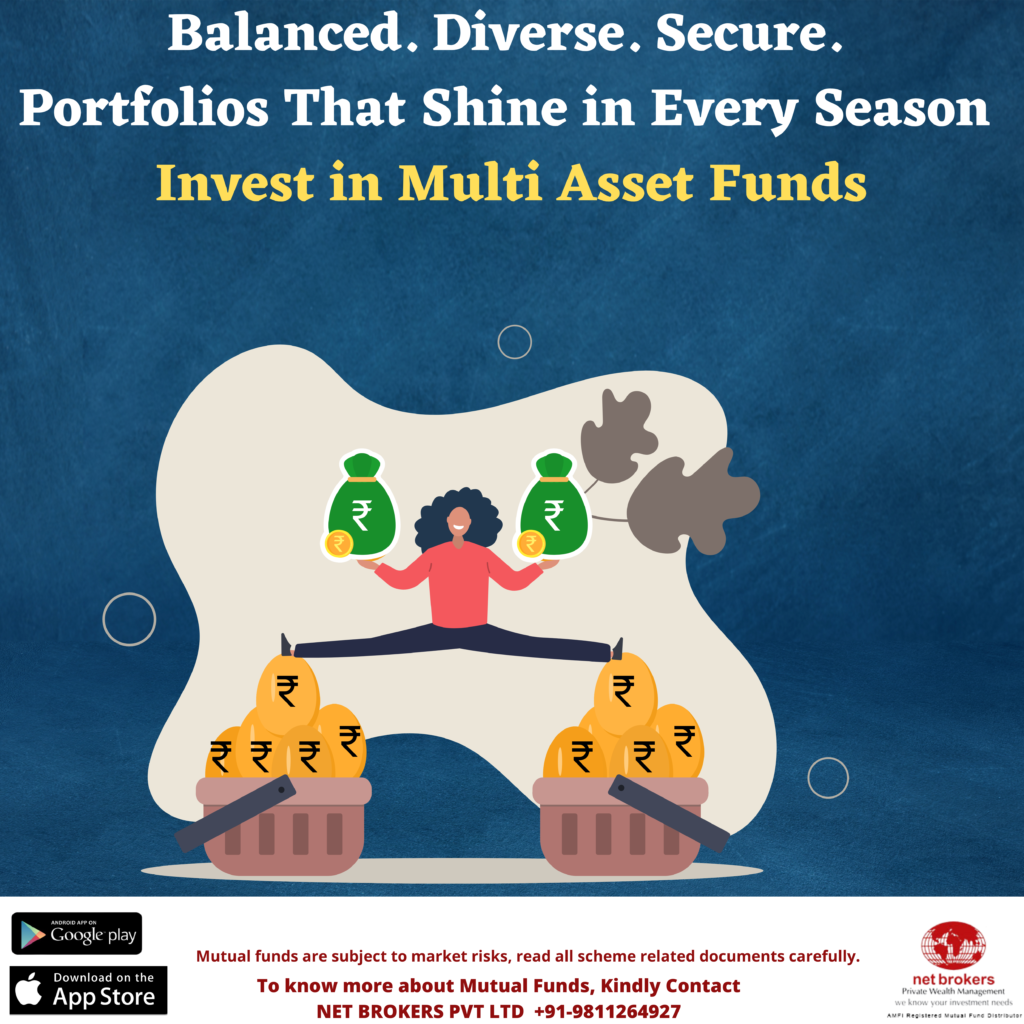Multi Asset Funds: A Balanced Platter of Investment Strategies
By Akhil Chugh
Date December 17, 2023
No more limiting to one, because it’s time to go for ‘three-in-one’!
Investing in today’s dynamic financial landscape can often feel like navigating a complex menu, with various asset classes offering different flavors of risk and return. In such a scenario, multi-asset funds emerge as a wholesome meal for investors, providing a diverse range of ingredients that work together to create a balanced and satisfying investment strategy.

A Multi Asset fund is a hybrid mutual scheme that invests in three or more diverse asset classes simultaneously. Typically, these funds include equity, debt, and gold exposure, with some also incorporating real estate investment trusts (REITs) and infrastructure investment trusts (InvITs).
Diversifying across various asset classes ensures resilience against the performance of a single class. When equities underperform, the debt portion may excel, and when both equities and debt struggle, gold may shine. Each asset class contributes distinct attributes to create a well-rounded asset allocation strategy, tailored to achieve financial goals in any market scenario.
This blog explores five reasons why choosing multi-asset funds is akin to enjoying a nourishing and well-rounded meal, especially in the face of market volatility.
How do Multi Asset Funds Work?
With asset allocation across different asset classes, Multi Asset Fund has the potential to deliver returns across all market conditions. This is because each asset class behaves differently in varied economic conditions. For example, it is very rare for both equity and debt investments to do equally well in the same period. Similarly, gold tends to do well when there is a gloomy outlook for the economy and all other asset classes are faring badly.

The fund manager chooses the right blend of asset mix based on the prevailing market conditions. This strategic asset allocation is decided by evaluating market situations and understanding each asset class’s role. For example, Equity helps in potential wealth creation, gold may help in economic uncertainties by acting as a hedge against inflation while debt can offer stability to your investment portfolio.
Why Investing in Multi Asset Funds is a Prudent Strategy to Navigate Volatility?
Five compelling reasons why choosing Multi Asset Funds could be a prudent strategy for investors looking to weather the storm of market uncertainty:
1. Diversification: A Balanced Plate of Assets

Just as a wholesome meal includes a variety of nutrients for overall well-being, multi-asset funds offer diversification across various asset classes. By blending equity, debt, and gold, these funds create a balanced portfolio that can withstand the impact of a downturn in any single asset class. Diversification acts as the main course, providing stability and reducing the risk associated with a concentrated investment approach.
2. Adaptability: Adjusting the Recipe to Suit the Palate
Like a chef adjusting a recipe to suit changing tastes, fund managers of Multi Asset Funds have the flexibility to adapt the portfolio to different market conditions. During times of economic uncertainty or heightened volatility, the fund can shift its allocation to more defensive assets like gold, acting as a protective layer. Conversely, in periods of economic growth, the portfolio can be adjusted to capture opportunities for capital appreciation by switching to equity. This adaptability ensures that investors are served a well-prepared dish regardless of market conditions.
3. Risk Management: Cooking Up a Safer Investment Dish
In the world of investing, risk management is akin to ensuring that the ingredients are fresh and prepared with care. Multi Asset Funds prioritize risk management by actively monitoring market trends and adjusting the portfolio accordingly. This risk-conscious approach is designed to shield investors from potential losses and ensures that the investment dish is both delicious and safe.

4. Income Generation and Growth: A Balanced Diet for Wealth Creation
A balanced meal includes both nutrients for sustained energy and those for growth. Similarly, Multi Asset Funds are designed to cater to both income generation and capital appreciation. By incorporating income-generating assets like bonds alongside growth-oriented equities, these funds provide investors with a well-rounded investment strategy. This dual approach acts as a balanced diet for wealth creation, satisfying both short-term income needs and long-term growth objectives.
5. Professional Expertise: A Skilled Chef in the Kitchen
Just as a skilled chef is essential for creating a memorable dining experience, professional expertise is crucial in managing a Multi Asset Fund. Experienced fund managers bring their knowledge and skill to the table, actively making decisions to enhance the flavor of the portfolio. This active management approach sets Multi Asset Funds apart from passive strategies, offering investors the opportunity to savor the benefits of professional insight in a rapidly changing financial environment.
How are Multi Asset Funds Taxed in India?
Multi-asset mutual funds offer flexibility in their allocation between equity and fixed income, adapting to various factors such as market conditions. To determine if at least 65 percent of the fund is invested in equities, we calculate the annual average based on monthly allocations. Taxation for these funds varies based on their equity orientation.
For equity-oriented funds, the tax treatment is akin to standard equity funds. If held for over a year, gains qualify as long-term capital gains. However, gains exceeding Rs 1 lakh incur a 10 percent tax rate. If the holding period is one year or less, it’s considered a short-term capital gain, taxed at 15 percent.
In the case of non-equity-oriented funds, gains are classified as short-term capital gains if the holding period is less than three years, and they are added to the investor’s income, subject to their applicable income tax slab. The gains are considered long-term capital gains for holdings exceeding three years and are taxed at 20 percent after accounting for indexation.
Key Takeaways from Net Brokers:
- Multi Asset Funds are known as– the “all-season” funds. However, while they aim to provide investors with steady returns in all market conditions, you should only invest in Multi Asset Funds if you are ready to stay invested for a long investment horizon.
- If you are a new investor unwilling to withstand present-day market volatility and with limited knowledge of different asset classes, SIP in Multi Asset Funds is ideal for you. These asset allocation funds can serve as risk-adjusted solutions.
- Multi Asset Funds are also the best category of mutual funds for passive investors who often do not want to rebalance their funds.
- Invest in Multi Asset Fund with an investment horizon of at least 5 years to earn the desired returns from your mutual fund investments.
In a world where the financial menu is vast and varied, opting for the balanced and flavorful approach of Multi Asset Funds can provide investors with a satisfying and nutritious investment experience.
Consult the Net Brokers team if you need any help knowing a scheme’s risk characteristics or your risk profile.
For more information, get in touch with us today!
Download our mutual fund app & start investing in different mutual fund schemes to attain your long-term financial goals.
Happy investing!



